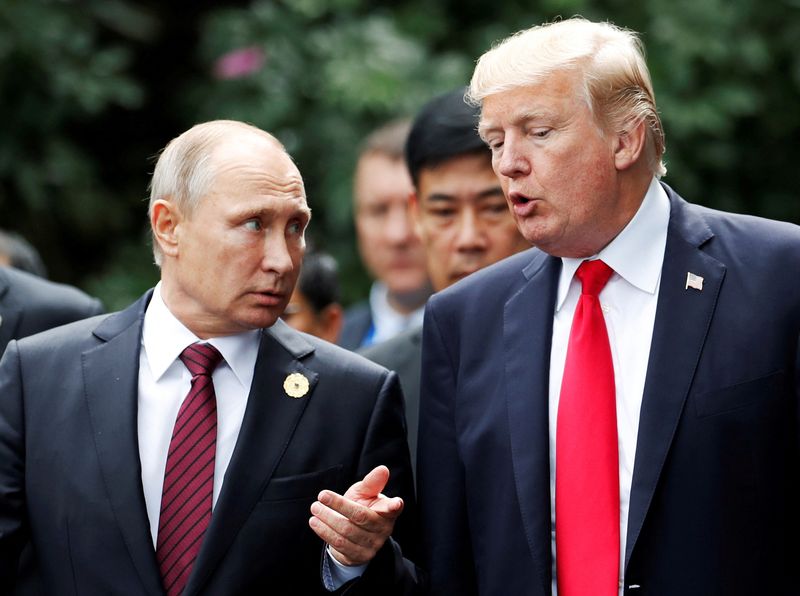
(Reuters) -Geopolitics is high on the agenda, with a potential meeting between the U.S. and Russian presidents, trade deadlines and talks, and markets bracing for United States' inflation data and rates decisions in Australia and Norway.
Here is your week ahead from Alun John, Amanda Cooper and Karin Strohecker in London, Rae Wee in Singapore, and Lewis Krauskopf in New York.
1/FACE TIME
Shuttle diplomacy is in full swing with U.S. President Donald Trump set to meet Russia's Vladimir Putin in the coming days - the first face-to-face summit between a sitting U.S. president and his Russian counterpart since Joe Biden met Putin in June 2021.
Trump - who has veered between admiration and sharp criticism of Putin - is looking for a breakthrough to end the 3-1/2 year war in Ukraine after voicing mounting frustration with his Russian counterpart and threatening new sanctions.
Ramifications of the encounter are likely to ripple through global markets with secondary tariffs set to hurt Russia and other nations around the world. Trump has imposed an extra 25% tariff on Indian goods, citing continued imports of Russian oil, and warned that China could be next.
Meanwhile, Ukrainian President Volodymyr Zelenskiy is pushing for Europe to be involved in the peace process and talks.
2/CHINA TRADE
There has been further progress in the makings of a trade deal between Washington and Beijing, or so Trump and his Treasury Secretary Scott Bessent have said.
But the August 12 deadline for a tariff truce between the world's two economic superpowers is closing in. Trump has yet to sign on the dotted line after both sides at talks in Stockholm agreed to seek an extension of a pause on tariffs.
Still, things seem somewhat positive for now. Trump has said he would meet Chinese President Xi Jinping before the end of the year should a trade deal be struck.
Investors, meanwhile, are craving more clarity, remaining largely on the sidelines and leaving Chinese markets range-bound for the most part, though stocks ended the week near a 10-month high.
3/TEST FOR FED BETS
Firming bets that the U.S. Fed is primed to resume cutting interest rates will be tested by Tuesday's release of U.S. inflation data.
The July consumer price index will also be watched for signs of the impact of Trump's tariffs deluge fuelling more price hikes. June data showed the biggest rise in five months, as higher costs for some goods were starting to bite.
A hot number could shake the narrative that the Fed will cut rates at its next meeting in September, which has gathered steam after a surprisingly weak employment report earlier this month.
The inflation report is also one of the most significant U.S. economic data releases since Trump fired the head of the Bureau of Labor Statistics after the weak jobs report - a move that stoked fears about data integrity and credibility.
4/SEPARATE WAYS
Australia's and Norway's central banks have been the two most cautious in developed economies in this cycle of rate cuts, but markets think their next moves could see them diverge.
The Reserve Bank of Australia only started easing this year, and has made just two 25 bps cuts from its 2024 peak, compared to a cumulative 100 bps for the Fed, and 200 bps for the ECB. Norway's central bank has made just one 25 bps cut.
In Australia, where inflation grew at its slowest pace in four years in the three months to June, markets expect a 25 bps reduction on Tuesday with one or maybe two more such cuts to follow this year.
The Norges Bank, in contrast, is set to stay on hold on Thursday, with another cut not fully priced until November.
Be nervous with market pricing though, at their last meetings both central banks confounded market expectations with Norway making its one cut, and Australia staying on hold.
5/IT'S QUIET...TOO QUIET
The middle of August is generally viewed as one of the dullest periods in the year. Lawmakers and central bankers are on a break, there is no big data and traders use the lull to ditch their screens.
There's just one small problem. August is when volatility has a habit of exploding - and last year was a case in point. A sharp appreciation of the Japanese yen, combined with a drop in U.S. tech stocks ignited one of the biggest one-day bursts in volatility on record.
The average daily percentage move in the VIX volatility index in August over the last 35 years is 0.55%, the highest for any month. The least volatile month is April - even with this year's meltdown after Trump's announcement of his "Liberation Day" tariffs - with an average daily move of 0.07%.
With stocks at record highs, and positioning in things like the dollar stretched, there is no shortage of tripwires.
(Compiled by Karin Strohecker; Graphics by Kripa Jayaram; Editing by Kate Mayberry)

 Reuters US Economy
Reuters US Economy
 Newsday
Newsday Associated Press US and World News Video
Associated Press US and World News Video America News
America News Newsweek Top
Newsweek Top Raw Story
Raw Story Reuters US Top
Reuters US Top Orlando Sentinel Politics
Orlando Sentinel Politics